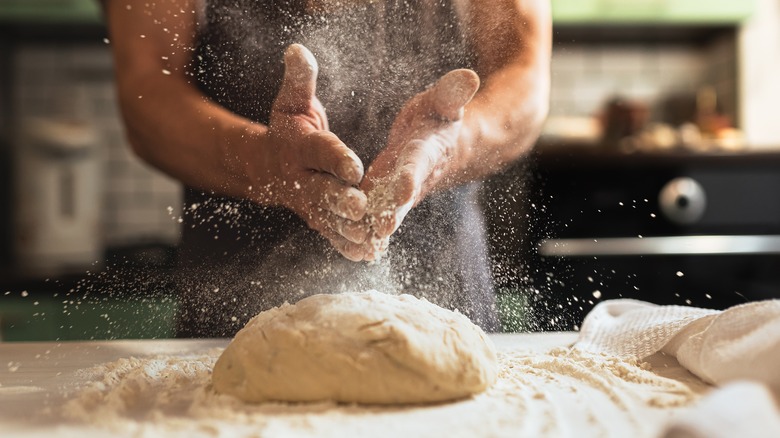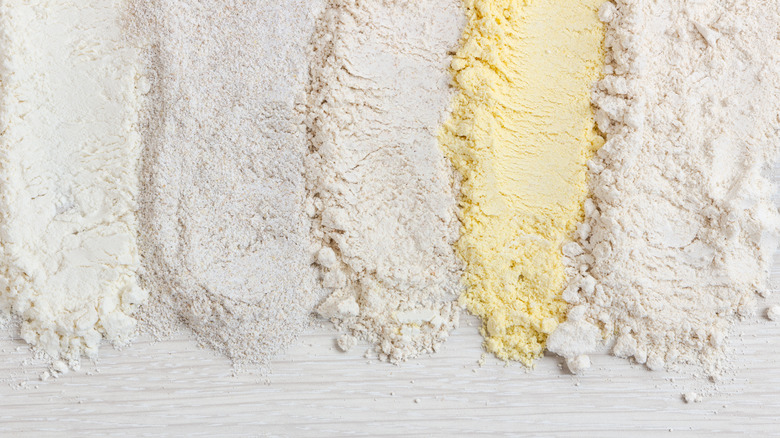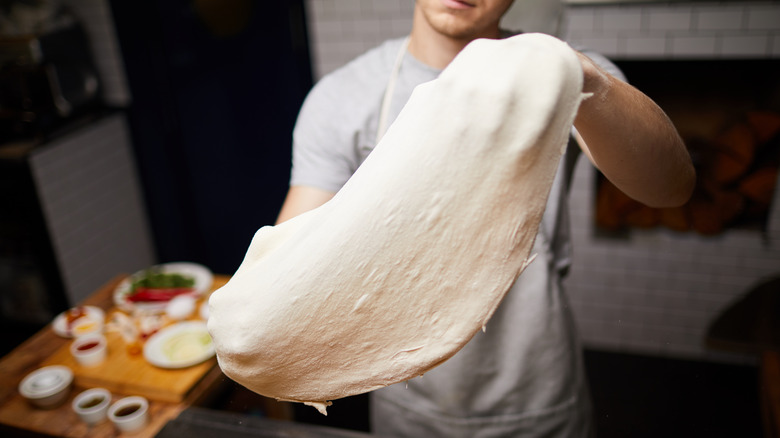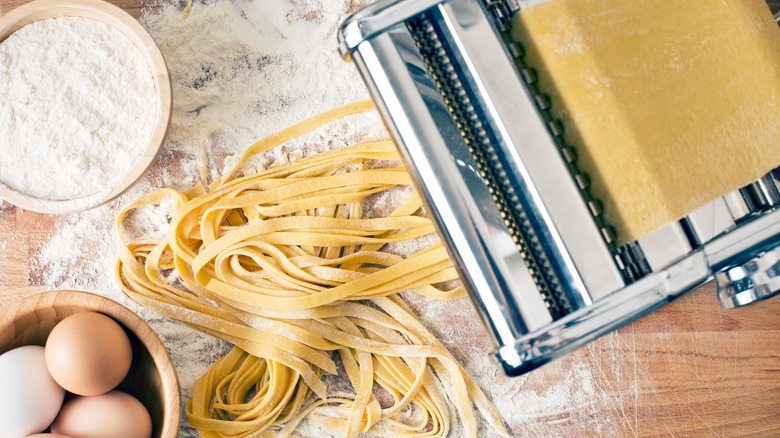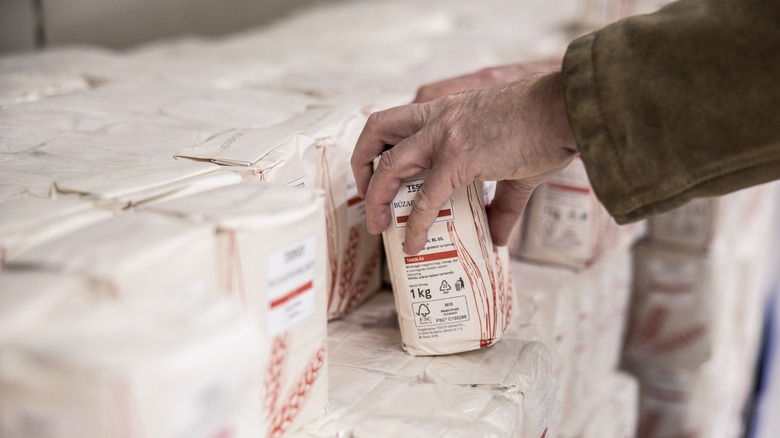What Is 00 Flour And How Is It Used?
We may receive a commission on purchases made from links.
Gone are the days when your mom or grandma would send you to the store for flour. You'd head to the market and grab the first package you saw — what else could it have been except all-purpose flour? Today, it's become necessary to specify the type of flour you need. A stroll down the flour aisle at the grocery store will show you the standard all-purpose, but also bread, self-rising, whole wheat, cake, almond, rice, coconut, spelt, rye, and potato flours, and that's not even all of them! Believe it or not, there is even cricket flour! According to the Farmers' Almanac, it is exactly what it sounds like — 100% ground-up crickets. It is naturally gluten-free and contains an impressive amount of protein.
The Pioneer Woman suggests that, with few exceptions, different kinds of flours are not interchangeable for a few reasons. Of course, some contain gluten, while others don't. Flours vary in taste, texture, and nutrients, and each flour will yield different results for rising, shaping, and consistency. A little-known flour outside the home, but a chef's favorite is 00 flour, and swapping it for unbleached all-purpose in your pizza crust will not give you the same result. It will be edible but perhaps not memorable. It is becoming more widely available at supermarkets, adding yet another flour option to your list of choices, but this one is in a class of its own.
What is 00 flour?
Double zero flour can also be tagged "doppio zero" due to its prominence in Italy, or even "pizza flour," according to Taste of Home. Typically made from soft wheat, as opposed to hard wheat, 00 flour has a high protein content but is relatively low in gluten, per MasterClass. It is more finely ground than other types of flour, giving it the luxurious texture of baby powder. It is named after the way Europeans classify a flour's grind size; a category of "2" is the highest type available and is equivalent to a large grind size, found in Italian white whole wheat flour, per Yumm Bazaar. Double zero flour is the finest-ground flour available.
MasterClass also notes that the amount of moisture in a recipe depends on a flour's grind size and that the finer the grind, the less liquid is necessary for the ideal texture. The protein in 00 flour is activated with less water than, say, all-purpose flour. This is in contrast to the way flours are classified in America. Fine, powdery flour, like cake flour, has lower protein, while coarse ground flours contain more.
How do you use 00 flour?
True to its identity, doppio zero flour is ideal for two of Italy's most recognized dishes: pizza and pasta. Its protein content and moisture requirements result in a dough that forms strong gluten, making it more elastic or able to withstand significant stretching without tearing — hello, thin-crust pizza! It can also be rolled out paper thin without breaking, as in spaghetti, per The Pioneer Woman. The more the dough is worked, the smoother it will become, according to Taste of Home.
When it comes to pizza, it's worth noting that double zero flour is the perfect choice to use if you're craving a Neapolitan-style pie, or one with a chewy, thin crust that has puffy edges generous in air pockets. This is exactly what this flour type will result in, per Taste of Home. If Chicago-style deep dish is more your thing, The Spruce Eats suggests that all-purpose flour is probably the best choice. The Pioneer Woman mentions double zero flour is also a good choice for crackers and flatter pieces of bread like focaccia.
How does it compare to other flours?
As wonderful as it is for making the aforementioned pizza and pasta, 00 flour is not the best choice to use in much else, which may be why it's one of the more difficult flour to find. According to Bon Appétit, it will not yield pillowy, soft bread loaves but does work in flatter (and chewier) pieces of bread like focaccia. And, unless you want a chewy cake or toothsome cookies or brownies you have to work hard to enjoy, steer clear of double zero. Interestingly enough, it is okay to substitute all-purpose flour for 00 flour. The Kitchn suggests that the resulting texture will be fine in your pizza and pasta but won't have the signature "chew" of authentic Italian recipes or dishes you might enjoy in Italy.
According to MasterClass, bread flour may be the closest flour you can get to 00 because it has a higher protein content and will result in a good chewiness and firm structure; however, it won't give you a super-crispy crust. For pasta, Bob's Red Mill suggests that semolina flour is an excellent choice because it, too, has a very high gluten content despite it being coarse ground flour. Pasta Evangelists note that 00 flour is best used in soft pasta shapes that you want neutral in flavor to let the other ingredients come through, such as ravioli. Meanwhile, semolina offers such a strong structure that it's ideal for pastas that should hold their shape well, like macaroni and penne rigate.
Where can you find 00 flour?
If available in your local grocery store or supermarket, you will find 00 flour amongst the sea of other flour in the baking section or the International aisle with Italian specialty ingredients. Larger towns and cities often have Italian markets that are more likely to sell this type of flour as well. In addition to its alternate names of "pizza flour" and "double zero flour," you may see it labeled as "tipo 00," Italian for "00 type." Fortunately, when all else fails, you should be able to order the flour online everywhere, from gourmet food websites to Amazon.
Unless you're making pizza and pasta regularly, a bag of 00 flour should last a while since you will probably only use it for these dishes. Pizza fans may enjoy the perfect pizza they've ever made, and pasta makers might never see a longer strand of linguine.
